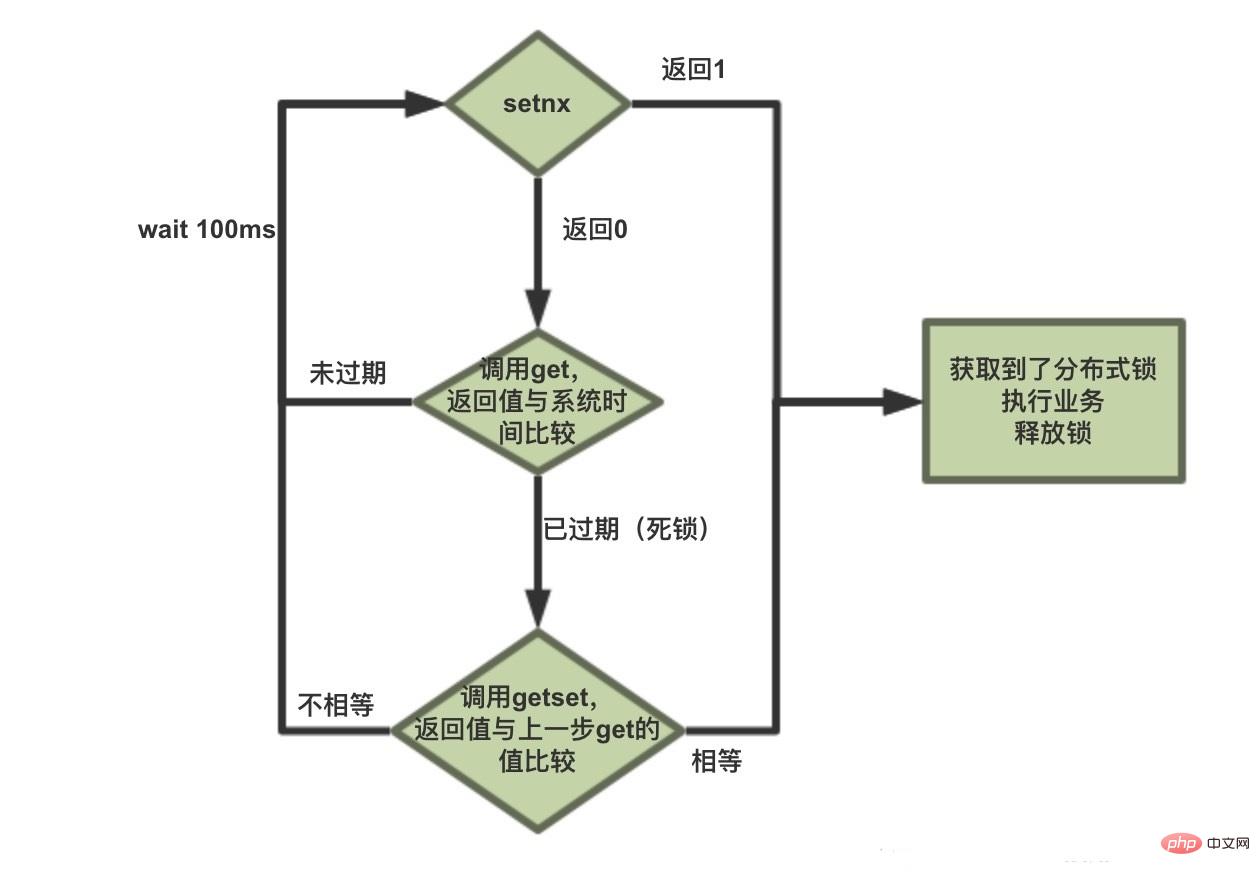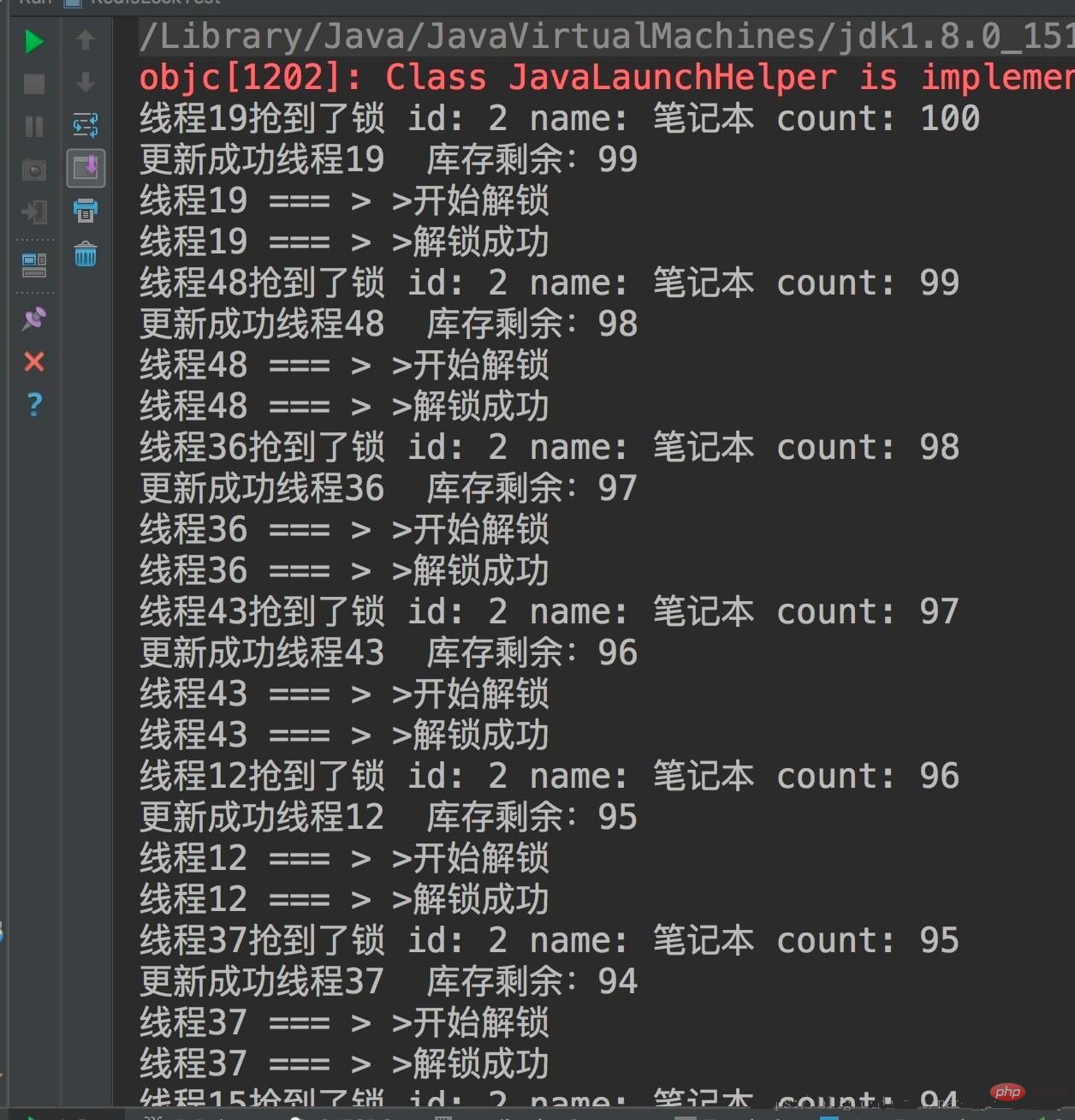How to implement the principle of redis distributed lock

#Distributed lock is a way to control synchronous access to shared resources between distributed systems.
In distributed systems, it is often necessary to coordinate their actions. If different systems or different hosts of the same system share one or a group of resources, then when accessing these resources, mutual exclusion is often required to prevent mutual interference and ensure consistency. In this case, it is necessary to Distributed locks are used.
Use the four redis commands setnx, getset, expire, and del to implement (Recommended learning: Redis video tutorial)
setnx is 『SET Abbreviation for "if Not eXists" (if it does not exist, then SET). Command format: SETNX key value; Usage: Set the value of key key to value only when key key does not exist. If the key key already exists, the SETNX command does nothing. Return value: The command returns 1 when the setting is successful and 0 when the setting fails.
getset command format: GETSET key value, sets the value of key key to value and returns the old value of key key before it was set. Return value: If the key key has no old value, that is, the key key does not exist before it is set, then the command returns nil. When the key key exists but is not of type string, the command returns an error.
expire command format: EXPIRE key seconds, usage: set the survival time for a given key. When the key expires (the survival time is 0), it will be automatically deleted. Return value: 1 is returned if the setting is successful. When the key does not exist or the lifetime cannot be set for the key (for example, if you try to update the lifetime of the key in a version of Redis earlier than 2.1.3), 0 is returned.
del command format: DEL key [key...], usage: delete one or more given keys, non-existing keys will be ignored. Return value: The number of deleted keys.
The principle of Redis implementing distributed locks:
1. Implemented through setnx(lock_timeout), if the lock is set, it returns 1, if there is already a value, it returns 0 if it is not set successfully.
2. Deadlock problem: judge whether it has expired through practice. If it has expired, get the expiration time get(lockKey), and then getset(lock_timeout) to judge whether it is the same as get. If it is the same, it proves that the lock has been successfully locked. , because it may cause multiple threads to execute the getset(lock_timeout) method at the same time, which may cause multiple threads to only need to getset. For the thread that determines the lock is successful, add expire(lockKey, LOCK_TIMEOUT, TimeUnit.MILLISECONDS) expiration time to prevent multiple Threads superimpose time at the same time, causing the lock aging time to double
 Code:
Code:
/**
* @author yaoxin
* @date 2018/8/13下午5:04
*/
public class RedisLockTest {
public static final String url = "jdbc:mysql://127.0.0.1:3306/ly?characterEncoding=UTF-8";
public static final String name = "com.mysql.jdbc.Driver";
public static final String user = "root";
public static final String password = "";
public static void main(String[] args) {
Integer count = 50;
while (count > 0) {
count--;
new Thread(new Runnable() {
@Override
public void run() {
Jedis jedis = new Jedis("127.0.0.1", 6379);
jedis.auth("1234");
String lock = lock(jedis);
if (lock != null) {
Statement statement = null;
Connection conn = null;
ResultSet resultSet = null;
try {
Class.forName(name);// 指定连接类型
conn = DriverManager.getConnection(url, user, password);// 获取连接
statement = conn.createStatement();// 准备执行语句
String querySql = "SELECT id,name,count FROM production WHERE id=2";
resultSet = statement.executeQuery(querySql);
int count = 0;
while (resultSet.next()) {
System.out.println(Thread.currentThread().getName() + "抢到了锁 id: " + resultSet.getString("id")
+ " name: " + resultSet.getString("name")
+ " count: " + resultSet.getString("count"));
count = Integer.valueOf(resultSet.getString("count"));
}
String updateSql = "UPDATE production SET count=" + (count - 1)
+ " WHERE id=2";
int rows = statement.executeUpdate(updateSql);
if (rows > 0) {
System.out.println("更新成功" + Thread.currentThread().getName() + " 库存剩余:" + (count - 1));
System.out.println(Thread.currentThread().getName() + " === > >开始解锁");
boolean unlock = unlock(jedis, lock);
if (unlock)
System.out.println(Thread.currentThread().getName() + " === > >解锁成功");
} else {
System.out.println("更新失败" + Thread.currentThread().getName());
}
} catch (Exception e) {
e.printStackTrace();
} finally {
try {
if (conn != null)
conn.close();
if (statement != null)
statement.close();
if (resultSet != null)
resultSet.close();
} catch (Exception e) {
e.printStackTrace();
}
}
}
}
}, "线程" + count).start();
}
}
public static String lock(Jedis jedis) {
try {
while (true) {
String lockTime = Long.valueOf(jedis.time().get(0)) + 5 + "";
if (jedis.setnx("lock", lockTime) == 1) {
jedis.expire("lock", 5);
return lockTime;
}
String lock = jedis.get("lock");
if (!StringUtils.isEmpty(lock) && Long.valueOf(lock) < Long.valueOf(jedis.time().get(0))) {
String oldLockTime = jedis.getSet("lock", lockTime);
if (!StringUtils.isEmpty(oldLockTime) && oldLockTime.equals(lock)) {
return lockTime;
}
}
Thread.sleep(100);
}
} catch (Exception e) {
e.printStackTrace();
}
return null;
}
public static boolean unlock(Jedis jedis, String lockTag) {
if (lockTag.equals(jedis.get("lock"))) {
jedis.del("lock");
return true;
}
return false;
}
}The running results are as follows:

For more Redis related technical articles, please visit the Redis Getting Started Tutorial column to learn!
The above is the detailed content of How to implement the principle of redis distributed lock. For more information, please follow other related articles on the PHP Chinese website!

Hot AI Tools

Undresser.AI Undress
AI-powered app for creating realistic nude photos

AI Clothes Remover
Online AI tool for removing clothes from photos.

Undress AI Tool
Undress images for free

Clothoff.io
AI clothes remover

Video Face Swap
Swap faces in any video effortlessly with our completely free AI face swap tool!

Hot Article

Hot Tools

Notepad++7.3.1
Easy-to-use and free code editor

SublimeText3 Chinese version
Chinese version, very easy to use

Zend Studio 13.0.1
Powerful PHP integrated development environment

Dreamweaver CS6
Visual web development tools

SublimeText3 Mac version
God-level code editing software (SublimeText3)

Hot Topics
 1386
1386
 52
52
 How to build the redis cluster mode
Apr 10, 2025 pm 10:15 PM
How to build the redis cluster mode
Apr 10, 2025 pm 10:15 PM
Redis cluster mode deploys Redis instances to multiple servers through sharding, improving scalability and availability. The construction steps are as follows: Create odd Redis instances with different ports; Create 3 sentinel instances, monitor Redis instances and failover; configure sentinel configuration files, add monitoring Redis instance information and failover settings; configure Redis instance configuration files, enable cluster mode and specify the cluster information file path; create nodes.conf file, containing information of each Redis instance; start the cluster, execute the create command to create a cluster and specify the number of replicas; log in to the cluster to execute the CLUSTER INFO command to verify the cluster status; make
 How to clear redis data
Apr 10, 2025 pm 10:06 PM
How to clear redis data
Apr 10, 2025 pm 10:06 PM
How to clear Redis data: Use the FLUSHALL command to clear all key values. Use the FLUSHDB command to clear the key value of the currently selected database. Use SELECT to switch databases, and then use FLUSHDB to clear multiple databases. Use the DEL command to delete a specific key. Use the redis-cli tool to clear the data.
 How to use the redis command
Apr 10, 2025 pm 08:45 PM
How to use the redis command
Apr 10, 2025 pm 08:45 PM
Using the Redis directive requires the following steps: Open the Redis client. Enter the command (verb key value). Provides the required parameters (varies from instruction to instruction). Press Enter to execute the command. Redis returns a response indicating the result of the operation (usually OK or -ERR).
 How to read redis queue
Apr 10, 2025 pm 10:12 PM
How to read redis queue
Apr 10, 2025 pm 10:12 PM
To read a queue from Redis, you need to get the queue name, read the elements using the LPOP command, and process the empty queue. The specific steps are as follows: Get the queue name: name it with the prefix of "queue:" such as "queue:my-queue". Use the LPOP command: Eject the element from the head of the queue and return its value, such as LPOP queue:my-queue. Processing empty queues: If the queue is empty, LPOP returns nil, and you can check whether the queue exists before reading the element.
 How to use redis lock
Apr 10, 2025 pm 08:39 PM
How to use redis lock
Apr 10, 2025 pm 08:39 PM
Using Redis to lock operations requires obtaining the lock through the SETNX command, and then using the EXPIRE command to set the expiration time. The specific steps are: (1) Use the SETNX command to try to set a key-value pair; (2) Use the EXPIRE command to set the expiration time for the lock; (3) Use the DEL command to delete the lock when the lock is no longer needed.
 How to read the source code of redis
Apr 10, 2025 pm 08:27 PM
How to read the source code of redis
Apr 10, 2025 pm 08:27 PM
The best way to understand Redis source code is to go step by step: get familiar with the basics of Redis. Select a specific module or function as the starting point. Start with the entry point of the module or function and view the code line by line. View the code through the function call chain. Be familiar with the underlying data structures used by Redis. Identify the algorithm used by Redis.
 How to solve data loss with redis
Apr 10, 2025 pm 08:24 PM
How to solve data loss with redis
Apr 10, 2025 pm 08:24 PM
Redis data loss causes include memory failures, power outages, human errors, and hardware failures. The solutions are: 1. Store data to disk with RDB or AOF persistence; 2. Copy to multiple servers for high availability; 3. HA with Redis Sentinel or Redis Cluster; 4. Create snapshots to back up data; 5. Implement best practices such as persistence, replication, snapshots, monitoring, and security measures.
 How to use the redis command line
Apr 10, 2025 pm 10:18 PM
How to use the redis command line
Apr 10, 2025 pm 10:18 PM
Use the Redis command line tool (redis-cli) to manage and operate Redis through the following steps: Connect to the server, specify the address and port. Send commands to the server using the command name and parameters. Use the HELP command to view help information for a specific command. Use the QUIT command to exit the command line tool.




